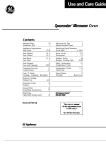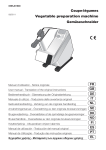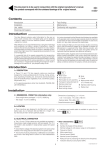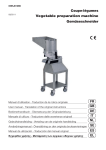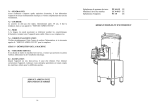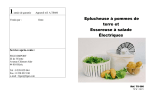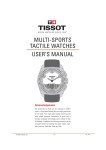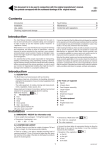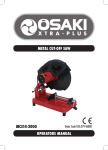Download T5 couv DESSINS .indd
Transcript
N°29516 E Eplucheuse 5Kg 05/2010 Vegetable peeler Gemüseschäl maschinen Manuel d’utilisation - Notice originale User manual - Translation of the original instructions Bedienerhandbuch - Übersetzung der Originalanleitung Manuale di utilizzo - Traduzione delle avvertenze originali Gebruikshandleiding - Vertaling van de originele handleiding Användningsmanual - Översättning av den originala bruksanvisningen Brugervejledning - Oversættelse af de oprindelige brugsanvisninger Brukerhåndbok - Oversettelse av den originale bruksanvisningen Käyttöohjekirja - Alkuperäisen ohjeen käännös Manual de utilización - Traducción del manual original FR GB DE IT NL SE DK NO FI ES T5S FR 05 09 T5S 08- 05/2009 T5S 07- 05/2009 T5S 06- 05/2009 T5S 05- 05/2009 T5S 04- 05/2009 T5S 03- 05/2009 T5S 02- 05/2009 T5S 01- 05/2009 This document is to be used in conjunction with the original manufacturer’s manual. The symbols correspond with the numbered drawings of the original manual GB 09/2009 Contents Introduction Installation Use, safety Cleaning, hygiene Fault finding Maintenance Conformity with regulations 1 1 3 4 5 5 7 Introduction The User Manual contains useful information for the user on how to work correctly and in complete safety, and is designed to make it easier to use the machine (called «machine» or «appliance» below). What follows is in no case intended to be a long list of warnings and constraints, but rather a series of instructions meant to improve the service provided by the machine in every respect, and particularly to avoid a series of injuries or damage to equipment that might result from inappropriate procedures for use and management. It is essential that all the people responsible for transporting, installing, commissioning, using, maintaining, repairing or dismantling the machine should consult this manual and read it carefully before proceeding with the various operations, in order to avoid any incorrect or inappropriate handling that might be result in damage to the machine or put people’s safety at risk. It is just as important that the Manual should always be available to the operator and it should be kept carefully where the machine is used ready for easy and immediate consultation in case of any doubt, or in any case, whenever the need arises. If after reading the Manual, there are still any doubts concerning how to use the machine, please do not hesitate to contact the Manufacturer or approved After Sales Service provider, who is constantly available to ensure quick and careful service for improved machine operation and optimum efficiency. Note that the safety, hygiene and environmental protection standards currently applicable in the country where the machine is installed must always be applied during all phases of machine operation. Consequently it is the user’s responsibility to ensure that the machine is operated and used solely under the optimum safety conditions laid down for people, animals and property. Introduction 1.1 DESCRIPTION • The vegetable peeler is mainly used for peeling, scrubbing and washing vegetables by adapting the equipment to the task to be performed. A Water inlet 1.1 B Removable cover C Electrical control housing D Adjustable drain E Stainless steel cylinder F G H I J K L Stand Tray for collecting the water Feet Removable filter basket (9 litre capacity) Hinged door and handle Outlet chute for vegetables Lid locking handle Installation ATTENTION!! Machine storage: -25°C to +50°C Ambient temperature during operation: +4°C to +40°C This machine is for professional use and must be used by staff trained to use, clean and maintain it, in terms or reliability and safety. Use the machine in adequately lit premises (See applicable technical standard for the country of use. In Europe, refer to standard EN 12464-1) When handling the machine, always check that the parts taken hold of are not mobile elements: risk of dropping and injury to the lower limbs. The machine is not designed for use in explosive atmospheres. 2.1 DIMENSIONS - WEIGHT (for information only) 2.1a - Gross weight packed, excluding equipment : 20Kg - Net weight excluding equipment 2.1b - Gross weight of stand + filter - Net weight of stand + filter : 17Kg : 18Kg : 16,5Kg 1 - Dimensions of packaging - Overall dimensions of T5S - Overall dimensions of stand : 520 x 410 x 480 mm : 500 x 320 x 450 mm : 590 x 454 x 670 mm T5S GB 10 07 2.2 LOCATION • • - • Install as follows : - Connect the elbow A, and the plastic tube to the outlet pipe B, of the vegetable peeler, and clamp them using the collar C. - Place the machine on the stand, introducing the equipped outlet pipe into the hole provided. - Attach the machine to the stand (4 screws and washers D). The vegetable peeler needs : connecting to the cold water system near a stop cock (see § 2.3). an adequate evacuation to the drains (see § 2.4). an electrical power supply (see § 2.5). The vegetable peeler may be fitted either : On a support that is fully stable, horizontal and not resonant (table, unit, sink top, etc.) of between 500 and 900 mm in height. 2.2c Note : Ensure that sufficient space is available above the machine so that the lid may be opened, and in front of the stand so that the basket may be removed. 2.2a Note :In this case, the machine may be moved easily after removing the plug and the flexible water inlet hose. - If necessary, pack and level the stand by unscrewing the retaining screw of the feet (10 mm socket spanner). - Adjust the foot then lock in position. - Check that the machine is completely stable. - The feet may be anchored by counter drilling their retention holes (dia. 5 x 40 screws and rawl plugs not supplied). Never place the T5S in a sink (water may enter the motor) - On a standard filter stand (optional) or a special pivoting stand (upon request) Choice of vegetables discharge on left G. 2.1b 2.2b 2.2d 2.3 CONNECTION TO THE WATER MAINS SYSTEM • The vegetabla peeler uses the mains pressure and reduced flow rate. • In conformity with the sanitary regulations, the machine’s water inlet is located above the overflow level, at a standardised distance (overflow device). • Connect the machine to a stop cock with a reinforced pipe of 15 mm internal diameter and clamped by means of a collar. Note : If the machine is to be moved around regularly, use a connection pipe that is fitted with quick release connectors. 2.4 DRAIN USED WATER AND SEPARATION OF WASTE - Vegetable peeler on filter stand : Attach the outlet pipe (B), internal diameter 88 mm to the under side of the tank for collecting the used water , using the collar to fasten to the drain. • The waste must be separated according to their size (peelings, skins, starch, moss, earth, etc.) depending on the different equipment that is used (see § 3.2). • Some installations have starch decantation tanks that may be directly connected. For other installations, we recommend installing the machine on a filter stand in order to avoid blockages and bad smells. • Possible installations : - Vegetable peeler without stand (near to a sink) : Place a filter basket or a strainer next to the peeler. 2.2a 2.2C • Tips : To drain used water correctly, avoid : - vertical drops onto inspection chambers (formation of foam), - sharp angles, - flattened, deformed or narrow pipes, - counter slopes, or slopes which are not steep enough. 2.5 ELECTRICAL CONNECTION ATTENTION!! Connection to the electrical power supply must be done according to proper professional practice by a qualified and authorised person (see current standards and legislation in the country of installation). If an adapter is used on the socket, a check must be made that the electrical characteristics of this adapter are not lower than those of the machine. Do not use multiple plugs The AC power supply to the machine must comply with the following conditions; - Maximum voltage variation: ±5% - Maximum frequency variation: ±1% on a continuous basis, ± 2% over short periods ATTENTION: the electrical installation must comply (for design, creation and maintenance) with the legal and standard requirements in the country where used. - Check that the electric mains voltage, the value shown on the specification plate and the label on the power cable are the same. - The machine’s electrical power supply must be protected against voltage surges (short-circuits and excess voltages) by using fuses or thermal relays of the appropriate gauge relative to the place of installation and machine specifications ATTENTION: Concerning protection against indirect contact (depending on the type of power supply provided and connection of the exposed conductive parts to the equipotential protection circuit), refer to point 6.3.3 of EN 60204-1 (IEC 60204-1) with the use of protection devices for automatic shut-off of power in the event of an insulation fault with a TN or TT, system, or for the IT system, with the use of a permanent insulation or differentials controller for automatic shut-off. The requirements of IEC 60364-4-41, 413.1 must apply for this protection. For example: in a TT system, a differential circuit breaker must be installed upline of the power supply, with a suitable power cut-off (e.g.: 30 mA) on the earthing installation for the place where it is planned to install the machine. ATTENTION: Failure to comply with these instructions means the customer runs the risk of machine failure and/or accidents due to direct or indirect contacts. T5S GB 09 09 2 • The machine is connected to a single phase supply by means of a moulded 2 pin + earth plug. • Before connecting the machine to the electrical power supply, check that the voltage of the electrical system is the same as that marked on the rating plate and the label on the power cable. • The machine must be protected by a differential circuit breaker and a 16 A fuse. To PAT test the Electrolux Range of Food Preparation Equipment, the PCB board needs to be disconnected before any test is done. This is due to the fact that the boards are fitted with a grounding diode that can give incorrect result during such a test. Also on a standard appliance a flash test of 25 amps and up to 3000v is used but, as you would expect, to use this on equipment, which has a printed circuit, board would be quite destructive to that board. We would recommend the use of a PAT tester approved for computer systems which use a lower rate of amps. The machine must be earthed. • Motor characteristics : Supply Nominal Frequency Current voltage (V) power (W) (Hz) The appliance is perfectly safe and is CE certificated. There are two ways to get overcome this problem. Electrical (A) 115 120 60 2,5 0,15 230 120 50 1,3 0,15 Consu. (kWh) · Disconnect the board as instructed and test using test for PC’s, · Or install the mixer on a fused spur (no plug) as this takes it away from being a portable appliance and the PAT test is then not needed. Use, safety ATTENTION !! Clean the machine properly prior to its first use This machine is for professional use and must be used by staff trained to use, clean and maintain it, in terms or reliability and safety. Use the machine in adequately lit premises (See applicable technical standard for the country of use. In Europe, refer to standard EN 12464-1) When handling the machine, always check that the parts taken hold of are not mobile elements: risk of dropping and injury to the lower limbs. Uncontrolled closure of the lid or ram press involves a risk of crushing the fingers. It is strictly forbidden to put the safety systems out of action or modify them: Risk of permanent injury!!!! Check that the safety devices operate correctly each time before using (see paragraph3.1). Never put a hand, a hard or frozen object in the appliance For health and safety reasons, always use a washable or disposable strong head covering that covers the hair completely. The machine is not designed for use in explosive atmospheres. 3.1 OPERATION - SAFETY • Normal operation of the machine is obtained if : - The door and the lid are closed. - The timer is set to continuous or timed operation. a) Starting up : - Turn the timer switch in an anti-clockwise direction to the continuous operation position. - Press the START button. b) Timed operation : - Turn the timer switch in a clockwise direction , graduated from 0 to 5. - Stops automatically when the timer reaches 0. c) Operation by pressing the START button : - When the door is opened to remove the products. d) Stopping - The STOP button should be used prior to opening the door or lid. The safety devices have priority over the ‘On’ order. • The safety of the user is ensured by : - A control system using constant pressure when the door is opened to evacuate the vegetables. - The stoppage of the motor when the lid is opened. - The START button needing to be pressed after stoppage («no voltage» device). - The design of the waste outlet zone, which avoids any blockage. - The design of the knife plate : protective edge and automatic emptying of the peelings. - Respecting the instructions of this manual for the use, cleaning and maintenance of the machine. • Control housing A Timer 3.1 C START button D STOP button E Continuous operation button F Timed operation button 3 T5S GB 10 07 3.2 DIFFERENT EQUIPMENT 3.2a • ABRASIVE PLATE - Smooth cutting of the skin into small faces, identical to peeling by hand. - Improves the presentation, conservation and cookability (economises cooking oil). - No production of starch or foam, a filter must be used. - For peeling vegetables with fine skins (new potatoes, carrots, salsifies, etc.). - The skin is rubbed off through contact with the abrasive surface. - The use of a filter is recommended for intensive use or small section drains. 3.2c • WASHING PLATE - For cleaning and washing tubers, fruits, new vegetables, etc. and any items that do not require peeling. - A filter may be required depending on the products to be processed. 3.2b • KNIFE PLATE - For peeling «thick» or «soft» skinned potatoes, carrots, celery, etc. 3.3 CAPACITIES (for information only) • Nominal loads per operation : Peeling potatoes (kg) : 5 3.4 USE OF EQUIPMENT Scrubbing tubers (kg : 5 3.4 - Turn the plate until the drive pin D drops into its housing B. This should drop in by its own weight. Note : Ensure that sufficient space is available above the machine so that the lid may be opened, and in front of the stand so that the basket may be removed. - Open the lid by turning the locking handle a quarter of a turn. - Hold the plate by the handle A and lower it, slightly tilted on the deflector side, until the hub B, connects with the drive shaft C. 3.5 PROCEDURE FOR PEELING, SCRUBBING AND WASHING • Loading - Open the lid. - Fit the selected plate onto the drive shaft and check that it has slotted into place (see § 3.4). - Check that the door is locked correctly and that the filter basket is in place. - Load the products and close the lid. • - Unloading Place a tray under the outlet chute. Close the water inlet stop cock.. When the door is opened, the vegetable peeler safety mechanism is operated. - With your right hand, press the START button (operation by keeping the button pressed down). - With your left hand, lift the door handle in order to channel the products out. - Programme the following operation by turning the timer switch until the cursor reaches the stop (see § 3.1). Note : The products must not be loaded above the edge of the cylinder. 3.5 Do not overload - Do not pack the products in - Overloading will damage the quality and speed of work. Note : Carefully monitor the peeling when the timer is in the continuous operation position. Do not forget to empty the filter basket when it is full or after peeling. - Partially open the water stop cock (see § 3.6) - Select the cycle time (see § 3.1). At the end of the cycle, the machine will stop automatically. 3.6 RECOMMENDATIONS FOR USE Do not use the abrasive plate for shellfish. • For peeling vegetables : with the abrasive or knife plates (see § 3.2); - The vegetables do not need to be washed before peeling. - Avoid peeling small quantities. - Peel vegetables of the same size. - Cut long vegetables (salsifies), tips, tops of carrots. - Peeling times : 1 to 2 minutes for new vegetables (potatoes, carrots), 3 to 5 minutes for the rest. • For scrubbing - washing vegetables and fruits : with the washing plate (see § 3.2) - Adjust the flow rate of the water to suit the dirtiness of the products. - Scrubbing time: from 1 to 3 minutes. Cleaning, Hygiene ATTENTION !! Before dismantling any part, disconnect the appliance from the power supply. Before using any cleaning product, be sure to read the instruction and safety instructions accompanying the product and use appropriate protective equipment. Do not clean the machine with a pressure cleaner T5S GB 10 07 4 4.1 AFTER USE - Close the lid and open the water stop cock as far as possible. - Operate the machine for a few seconds to get rid of the remaining waste and to rinse the inside of the machine. - Open the lid, move it away to the left to remove it and rinse under the tap. - Remove the equipment and clean it with a brush if it is dirty. - Check that the bottom of the peeling chamber, the hub and the drive shaft of the equipment have been cleaned correctly. - The filter basket must be emptied then cleaned under the tap, along with the tray. - Clean the outside of the machine using a damp sponge. - Leave the lid open and the door ajar in order to ventilate the peeling chamber and avoid squashing the seals. Note : Do not use abrasive detergents which scratch the surfaces, or chlorine based products which can dull the aluminium or cause the plastic to crack. Fault finding 5.1 THE MACHINE WILL NOT START, CHECK THAT : • The machine is plugged in. • The electrical power supply to the socket is correct. • The lid and the door are both closed. 5.2 ABNORMAL NOISES • Stop the machine. • Check that the rotating parts are fitted correctly (see § 3.4). • Verify that there are no stones or foreign bodies in the peeling chamber (risk of jamming and damaging the plate). • If the noise persists and the machine operates abnormally when empty, check if : - The belt is worn (see § 6.1). - The plate turns freely by hand. 5.3 JAMMING OF A PLATE - Disconnect the machine. - Unscrew the central screw of the plate using 13 mm spanner. - Remove the handle washer. - Retighten the screw to lift the plated and remove it. - Refit the plate and screw to the plate. Note : Clean and grease regularly the drive shaft of the machine with tallow or an animal grease. 5.4 WORK QUALITY • - Inadequate or irregular peeling, with flats may be caused by : Insufficient peeling time (see § 3.6). Overloading of the products (see § 3.3). Vegetables which are too long, too soft or of unequal thickness. - An abrasive plate which is worn or dirty or a knife plate with damaged blades (see § 6.2). If the problem persists, contact the service department of your local dealer Maintenance ATTENTION!! Unplug the machine before carrying out any operation. All access to the electrical parts requires the use of a tool. Maintenance may only be carried out by a qualified, trained and authorised person. 6.1 MECHANISM • The vegetable peeler only requires a minimum amount of maintenance (the bearings of the motor and mechanism are greased for life). • It is recommended that the following be checked at least once a year : - The condition of the flexible water inlet pipe and its attachment. - He wear of the belt. • To access the mechanism, motor and electrical components : - Disconnect the machine. - Detach the machine from the stand, if fitted (4 attachment screws). - Turn the machine over and remove the 4 screws which attach the base. • The capacitors may retain an electrical charge. To avoid taking any risks when carrying out work, we recommend discharging them by connecting their terminals with an insulated conductor (e.g. a screwdriver). • Changing the toothed belt : - Unscrew by 2 turns the 2 motor attachment screws (10 mm hexagonal spanner). - Bring the motor closer and slide onto the drive pulley to remove the belt. - Fit a new belt. - Lightly tension the belt, using a screwdriver as a lever between the motor and the bearing. - Retighten the 2 motor attachment screws. Residual voltage at the capacitor terminals. 5 T5S GB 10 07 6.2 MAINTENANCE OF THE EQUIPMENT • ABRASIVE PLATE : Inefficient - Used ramps or worn abrasive layer which has revealed the base of the plate (poor peeling of the vegetables and formation of flats): change the plate. - dirty plate (calcium, starch or soil deposits): brush the plate. - Use a water cooled grinding wheel , taking care to keep the same cutting angle After sharpening several times, the thickness of the cut will increase. Replace worn blades. • KNIFE PLATE : resharpening of the blades - Remove the attachment screws. • WASHING PLATE : Damaged or worn edges - Change the brush. - Unscrew the two attachment screws underneath the plate and remove the brush. 6.3 ADJUSTMENT OF THE SAFETY DEVICES • Check that the safety devices are operating correctly on a regular basis. The motor should stop : - when the lid is opened. - when the door is opened. • If either of the two safety devices do not work : - do not use the machine. - Have it adjusted by the service department of your local dealer. 6.4 ELECTRICAL COMPONENTS 6.4 See electrical diagrams. • Identification of the colours of the wires : - Power circuit : black - Control circuit : red or colour wire cable : (D) brown / (E) grey / (F) white - Motor : A : blue / B : red / C : black / D : brown - Phase : L1 - Neutral : N - Earth : B/C green /yellow S1 S2 M CPu Mi CD CP MA : : : : : : : : Door safety device Lid safety device Motor Power card Timer Start-up condenser Permanent condenser Start-up relay • Identification of the components : O : Stop button I : Start button Fu : Fuse 6.5 ADDRESS FOR SERVICE REQUIREMENTS We advise you to contact the dealer who sold you the machine. Dealer’s stamp For any information or orders for spare parts, specify the type of machine, its serial number and the electrical characteristics. - The manufacturer reserves the right to modify and make improvements to the products without giving prior warning. T5S GB 10 07 Date of purchase: ................................. 6 Conformity with regulation The machine has been designed and manufactured in conformity with : - The machine directive 2006/42 EEC, - The CEM directive 2004/108EEC, - 2006/95/EEC: Low Voltage Directive - 2002/95/EC: Equipment recycling directive 2002/96/CEE « WEEE » The symbol « » on the product indicates that this product may not be treated as household waste. Instead it shall be handed over to the applicable collection point for the recycling of electrical and electronic equipment. By ensuring this product is disposed of correctly, you will help prevent potential negative consequences for the environment and human health, which could otherwise be caused by inappropriate waste handling of this product. For more detailed information about recycling of this product, please contact the sales agent or dealer for your product, your after-sales service, or the appropriate waste disposal service. 2006/12/CEE“Waste” The machine is designed so that it does not contribute, or as little as possible, to increasing the quantity or harmfulness of the waste and the risks of pollution. Make sure to observe the recycling conditions. 94/62/CEE“Packaging and packaging waste” The packaging for the machine is designed so that it does not contribute, or as little as possible to increasing the quantity or harmfulness of the waste and the risks of pollution. Make sure to eliminate the various parts of the packaging in appropriate recycling centres. - To the European standards : EN 13208-2000: Vegetable-peeling machines, hygiene and safety. This conformity is certified by: - The CE conformity mark, attached to the machine. - The corresponding CE declaration of conformity, associated with the warranty. - This instruction manual, which must be given to the operator. Acoustic characteristics: - The acoustic pressure level measured in accordance with the test code EN ISO 3743.1-EN ISO 3744. Protection indices as per the EN 60529-2000 standard: - IP55 electrical controls. - IP34 overall machine. Integrated safety devices - The machine has been designed and manufactured in compliance with the relevant standards and regulations, mentioned above. - Before using the machine, the operator must be trained to use the machine and informed of any possible residual risks (personnel training obligation) Food hygiene: The machine is made from materials that conform to the following regulations and standards: - 1935/2004 EEC materials and objects in contact with foodstuffs - EN 601-2004: cast aluminium objects in contact with foodstuffs - Directive EN 1672-2-2005 : Prescriptions relating to hygiene The surfaces of the food area (excluding the abrasive parts) are smooth and easy to clean. Use detergents that are approved for food hygiene and respect the instructions for their use. 7 T5S GB 10 07 Schéma électrique / Electrical wiring diagram BRANCHEMENT MONOPHASÉ / SINGLE PHASE CONNECTION 6.4 Machine semaine 47/00 - Machine week 47/00 T5S FR 12 07 M • Repérage des couleurs des fils : - Circuit de puissance : noir - Circuit de commande : rouge ou cable fils couleur : (D) marron - (E) gris - (F) blanc - Moteur : (A) bleu - (B) rouge - (C) noir - (D) marron - Phases : L1 - Neutre : N - Terre : B/C vert / jaune . • Repérage des composants : O : Bouton poussoir ARRET I : Bouton poussoir MARCHE S1 : Sécurité porte S2 : Sécurité couvercle M : Moteur CPu : Carte puissance Mi : Minuterie CD : Condensateur de démarrage CP : Condensateur permanent MA : Relais de démarrage Fu : Fusible • Identification of the colours of the wires : - Power circuit : black - Control circuit : red or colour wire cable : (D) brown / (E) grey / (F) white - Motor : A : blue / B : red / C : black / D : brown - Phase : L1 - Neutral : N - Earth : B/C green /yellow • Identification of the components : O : Stop button I : Start button S1 : Door safety device S2 : Lid safety device M : Motor CPu : Power card Mi : Timer CD : Start-up condenser CP : Permanent condenser MA : Start-up relay Fu : Fuse













